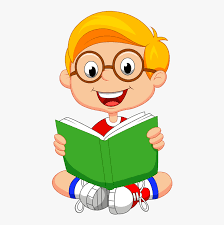
Today, people often see reading aloud as a boring chore and a waste of time, but a plethora of studies highlight how important it is – and not for just beginning readers, but for adults, too.
Image from clipart-library.com
Before Books
Before books became affordable to the populace, stories were told through the art of the oral tradition and handed down from one generation to the next. It was a time when families came together of an evening and shared their love of stories. When you think about it, this art would have:
- led to the building of memory
- built an understanding of how language structure worked
- increased vocabulary
- increased attention spans
- improved listening skills
- allowed for imagination to be set free, thereby engaging the brain
- provided time to engage with others
How things have changed since the advent of first, the radio, then TV, computer games, and now social media.
Today, people often see reading aloud as a boring chore and a waste of time, but there is a plethora of studies that highlight how important this past-time is, for not just beginning readers, but for adults, too.
My Memories
As a youngster, I remember reading my reader aloud to Mum each afternoon. Back then it was the Reading Time books with Penny and her brothers, followed by Dick and Dora, then the Wide Range Readers. Educators today don’t like those books, but as a child I loved them. I can’t remember exactly when it was that I stopped reading to Mum, but I think it was sometime soon after starting on the Dick and Dora.
Then there was my favourite time of the evening – sitting in bed and listening to Dad as he read stories such as the Tales of Blinky Bill.
Image from clipart-library.com

After a full-on day, this was the perfect moment for me. It was a time to connect with Dad, who had spent weeks away at work during my early years and provided slowdown time that led to relaxation of the mind in readiness for sleep. It was also an activity that connected me with new vocabulary, the flow of written words that allowed me to envision the action, and a time to talk about the story or chapter read.
Not many of my class teachers read stories to us, but those who did are amongst the ones I remember best. As a child on the spectrum – and undiagnosed – on library visits I returned to the same books again and again. These teachers not only fostered my love of reading, but they also introduced me to new authors, and by that broadened my horizons. This was an end of day ritual that enabled me to become immersed in the stories, whilst unknowingly learning new vocabulary, adding to my understanding of sentence structure and building on the development of memory – and all done whilst relaxing.
Studies have shown that brain activity in children changes according to the type of learning experience they are engaging in. A higher number of neurons fire in children’s brains when they are listening to a story, compared to when they are watching a movie or engaging in screen time. (Gurdon, 2019)
Reading Aloud to Kids

As a teacher, reading aloud to my young students after lunch and just before home time, was a daily ritual.
Image from clipart-library.com
Often it was picture books, but I also incorporated chapter books and non-fiction into the mix. Chapter books provided a sense of anticipation for the next day’s read and offered an opportunity to talk about the previous chapter read, whilst non-fiction texts delivered a different type of language experience. This was a time where the children could relax, imagine, listen to the flow of language and share as their minds unknowingly engaged in concentration as they listened.
When reading aloud to my students, I modelled fluent reading and encouraged them to listen for new vocabulary that we could discuss its pronunciation, look at its spelling and talk about its meaning. This was also a time when we discussed features such as plot, setting, characters and so forth.
I also introduced a time of day where children could read to the class. For the early readers, it was generally their take home reader, whilst advanced readers often chose a book from our class library. This also provided an opportunity for them to hone their fluency and intonation as they put into practice the skills we worked on in individual and group sessions. You may ask, ‘What about the poor readers?’ I always ensured they had a text they knew well, and the children knew I would help with the tricky words they couldn’t remember.
Kids Reading Aloud
‘Children who are read aloud to more often and have who have access to a range of books show higher levels of receptiveness as well as the ability to understand literacy and language.’ (Phillips 2000)
When reading aloud,
a child:
Image from clipart-library.com

- pays close attention to every word which leads to better understanding what they are reading
- increases their reading speed as they become more proficient
Lastly, when a child reads aloud, this helps you as a parent or teacher to see how well they are reading and where improvement is required.
Listening to your child read aloud enables you to listen for accuracy:
Encouraging the early reader, or the child experiencing difficulties, to point to each word as they read means they won’t skip any. Skipping words can lead to loss of understanding of the text if keywords are missed.
- Are they missing words, pronouncing words incorrectly?
- Are they missing words?
Listening to your child read aloud enables you to listen to phrasing:
When phrasing correctly we’re talking about intonation and fluency. Generally, correct phrasing means a child understands what they are reading. A beginning reader may be slow, but they can still be reading fluently at that pace,
Questions to ask yourself are:
- Are the correct words being emphasised?
- Is my child pausing in the correct spots? i.e. at full stops and commas.
- Is my child raising their voice at a question marks?
- If it’s a funny sentence, do they laugh or make comments such as ‘That’s funny.’?
The last key item to look for when your child reads aloud is speed:
Stumbling over words and reading very slowly cause a loss of understanding. This often mean the text is too advanced.
A rapid paced reading also leads to loss of understanding because accuracy is often lost, words corrections not made, and phrasing is lost. This child will need to slow down. Sometimes a return to pointing to each word may be required, or another avenue that can be used is using a piece of card so that only one line at a time is uncovered.
Questions to ask your child to find out if they understand what they are reading are:
- Did that make sense?
- How did that sound?
- What did that mean?
- Did that sound right?
Children who read aloud ‘display higher creativity an imaginative capability, as they can visualise mental images.’ (Gurdon, 2019)

In closing, reading aloud is beneficial on multiple levels for both adult and child. It provides a time of connection, communication, language development, creativity, and sharing.
Image from clipart-library.com
Reading Rockets has some great articles that help adults and children have great discussions about books and more.
Links
Reading Guide 101 for Parents: Click HERE
Reading with your Child: Click HERE
Literacy Tips for Parents: Click HERE
Summer Reading and Learning: Click HERE
Dialogic Reading: Having a Conversation about Books: Click HERE
Sharing Wordless Picture Books: Click HERE
How to choose Books to Read Aloud: Click HERE
Getting the Most out of Nonfiction Reading Time: Click HERE

